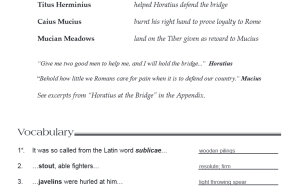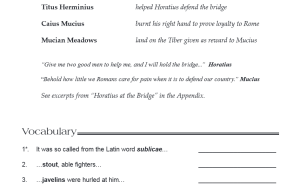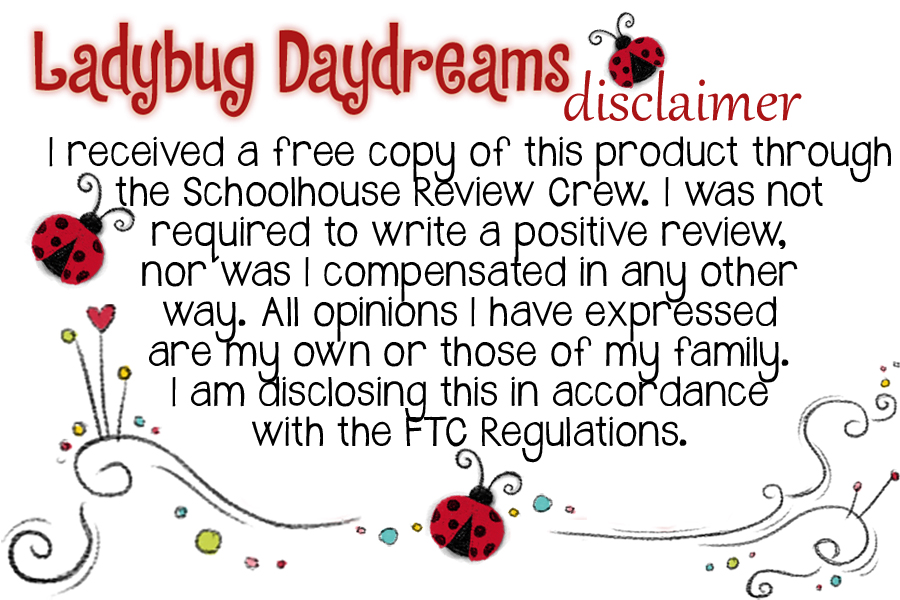Will is super into Roman history. He likes watching the TV shows about it, and he’s even read a college level Roman history textbook for fun. Twice. So when the opportunity arose to review an elementary/middle school Roman history curriculum, I knew he’d approve. And that the boys would be very interested in learning about something that so fascinates their father. Additionally, given that the curriculum is produced by Memoria Press, whose catalog/magazine we receive quarterly and enjoy reading, I was confident that Famous Men of Rome would be a quality product.
 The curriculum is a three-book set, all of which are (approximately; I haven’t measured them) 8.5 x 11 softcover books. There’s the text book, the student guide, and the teacher guide. These are available separately ($17.95 for the student and teacher books, $16.95 for the text book) or together for $39.95. To supplement the set, there are also flashcards available ($12.95), but I didn’t receive those so I can’t really tell you how good or “necessary” they are to the product. The text has 30 chapters, each focusing on – you guessed it – a famous leader of the Roman empire (well, the first 29 do; the final chapter deals with the end of the western empire).
The curriculum is a three-book set, all of which are (approximately; I haven’t measured them) 8.5 x 11 softcover books. There’s the text book, the student guide, and the teacher guide. These are available separately ($17.95 for the student and teacher books, $16.95 for the text book) or together for $39.95. To supplement the set, there are also flashcards available ($12.95), but I didn’t receive those so I can’t really tell you how good or “necessary” they are to the product. The text has 30 chapters, each focusing on – you guessed it – a famous leader of the Roman empire (well, the first 29 do; the final chapter deals with the end of the western empire).
The book starts with the founding of Rome by Romulus, and even though Memoria Press is a staunchly Christian company, they don’t shy away from the Roman mythology in this series. The book is written so that we can understand the ancient history of Rome the way it’s told traditionally, not just the way it literally happened. For example, as tradition goes, Romulus and Remus were twin brothers whose human mother slept with the god Mars, thus conceiving the twins. She died, and because their father was a god, he didn’t necessarily spend a lot of time hanging out on Earth, so the boys were adopted by a she-wolf who nursed them and raised them as her own (the story kind of reminded me of The Jungle Book). Eventually, they grew up and left their wolf family. They founded the city together, and each wanted to name it after himself. Despite having come up with a way to decide who should “win,” when the sign came, both thought they were the winner (Remus based on the timing of the sign, Romulus based on what the sign was). But Romulus was more . . . gutsy, shall we say. He went ahead and named the city after himself, Roma (Rome in English), and built a wall around it. Remus came to visit the city some time later, and after he mocked his brother’s walled city, Romulus killed him, thus becoming the first official emperor of Rome.
So you see, we as Christians (well, as modern thinkers, whether Christian or not) know that Romulus and Remus couldn’t possibly have been fathered by the god Mars – because he doesn’t exist. But that’s the way the story goes, so that’s what we get from Famous Men of Rome. Stories like that one opened up a lot of conversation opportunities with the boys regarding Roman mythology and why we learn about it but don’t believe it.
The text is written to feel like a story, which makes it really easy to read and understand. We all sat around the living room while I read the chapters (one per week) aloud. Sometimes Will even joined us. The kids (ages 2, 8, and 11) really enjoyed the stories, and because of the writing style, they really retained the information throughout the week. In order to extend the lesson a full week, I would spend one day reading the story, we’d do the comprehension questions from the teacher/student guide another day, and the other activities (a timeline, map work, vocabulary, and other activities) on a third day. This schedule worked really well for us; we got a lot of good Roman history groundwork laid in the kids’ minds, and it didn’t take too long. That’s important with my kids; they don’t like working on one subject for very long, so products that work well in just a short period are really appreciated.
The teacher guide and student guide are nearly identical inside. The only difference is that the teacher guide lists the answers, whereas the student guide has blanks for the children to write. In order to include both Seahawk and Munchkin in the “process,” though, we did most of the work orally. It worked out better that way for us, anyway, because the boys don’t really love writing and they’re doing plenty of that in other subjects. I didn’t feel it was necessary to push it in the history class.
So, what did we think of the curriculum? We liked it a lot. There’s a lot of ways to expand it with outside videos and other books, but none of that is necessary. It stands on its own just fine. For those of you who like to take a curriculum and “make it your own,” this would be an awesome product for you. If you like to just use a product “as is,” these books work that way, too. I love the flexibility, even if I’m normally a “use it how it is” kind of teacher. I think my favorite part of the curriculum, though, is that Will was excited about what the boys were learning and took it upon himself to go over some of the things we were learning more in-depth with the knowledge he’s gleaned from other books. Normally, he likes that the kids are learning, but isn’t so concerned with what they’re learning. This time, he took a real interest, and I loved that. If for no other reason, this set of books was a blessing to our family.
Have a great day!
Blessings,
Members of the Schoolhouse Review Crew are reviewing a variety of products from Memoria Press this week: Famous Men of Rome, Latina Christiana (for learning Latin), and The Book of the Ancient Romans (similar to Famous Men, but for older students). Click the banner below to read more of those reviews!





